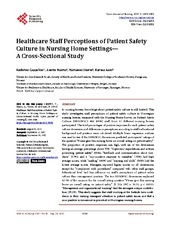| dc.contributor.author | Cappelen, Kathrine | |
| dc.contributor.author | Harris, Anette | |
| dc.contributor.author | Storm, Marianne | |
| dc.contributor.author | Aase, Karina | |
| dc.date.accessioned | 2018-03-01T16:03:44Z | |
| dc.date.available | 2018-03-01T16:03:44Z | |
| dc.date.issued | 2017 | |
| dc.Published | Cappelen K, Harris A, Storm M, Aase K. Healthcare staff perceptions of patient safety culture in nursing home settings - a cross-sectional study. Open Journal of Nursing. 2017;7(9):1069-1085 | eng |
| dc.identifier.issn | 2162-5344 | |
| dc.identifier.uri | https://hdl.handle.net/1956/17452 | |
| dc.description.abstract | In nursing homes, knowledge about patient safety culture is still limited. This study investigates staff perceptions of patient safety culture in Norwegian nursing homes, measured with the Nursing Home Survey on Patient Safety Culture (NHSOPSC). 466 (69%) staff from 12 different nursing homes participated. The total percentages of positive responses for each patient safety culture dimension and differences in perceptions according to staff’s educational background and position were calculated. Multiple linear regression analysis was used to test if the NHSOPSC dimensions predicted participants’ ratings of the question “Please give this nursing home an overall rating on patient safety”. The proportion of positive responses was high, with six of ten dimensions having an average percentage above 70%. “Supervisor expectations and actions promoting patient safety” (88%), “feedback and communication about inci- dents” (87%), and a “non-punitive response to mistakes” (78%) had high average scores, while “staffing” (46%) and “training and skills” (56%) had the lowest average scores. Managers reported higher scores on all dimensions, except for “compliance with procedures” compared with other staff groups. Educational level had less influence on staff’s perceptions of patient safety culture than management position. The ten NHSOPSC dimensions explained 47.2% of the variance for the overall rating question “Please give this nursing home an overall rating on patient safety” (F [10, 384] = 34.39, p < 0.001). “Management and organizational learning” had the strongest unique contribution (28.1%). This study suggests that staff working at the bedside have confidence in their nursing managers’ attention to patient safety issues and that a non-punitive environment is prevalent in Norwegian nursing homes. | en_US |
| dc.language.iso | eng | eng |
| dc.publisher | Scientific Research Publishing | eng |
| dc.rights | Attribution CC BY | eng |
| dc.rights.uri | http://creativecommons.org/licenses/by/4.0 | eng |
| dc.subject | Patient Safety | eng |
| dc.subject | Safety Culture | eng |
| dc.subject | Nursing Home | eng |
| dc.subject | Perceptions | eng |
| dc.subject | Cross-Sectional Survey | eng |
| dc.title | Healthcare staff perceptions of patient safety culture in nursing home settings - a cross-sectional study | eng |
| dc.type | Peer reviewed | |
| dc.type | Journal article | |
| dc.date.updated | 2018-01-31T12:33:57Z | |
| dc.description.version | publishedVersion | |
| dc.rights.holder | Copyright 2017 The Author(s) | eng |
| dc.identifier.doi | https://doi.org/10.4236/ojn.2017.79078 | |
| dc.identifier.cristin | 1506797 | |
| dc.source.journal | Open Journal of Nursing | |
| dc.relation.project | SHARE - Centre for Resilience in Healthcare: 7291 | |
| dc.relation.project | Norges forskningsråd: 204637 | |

